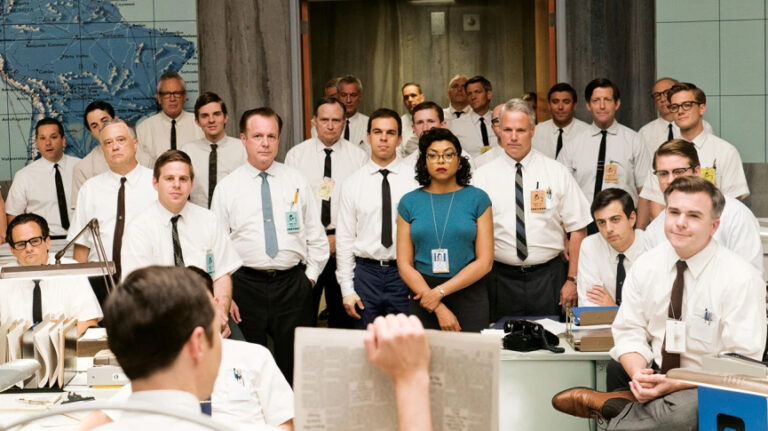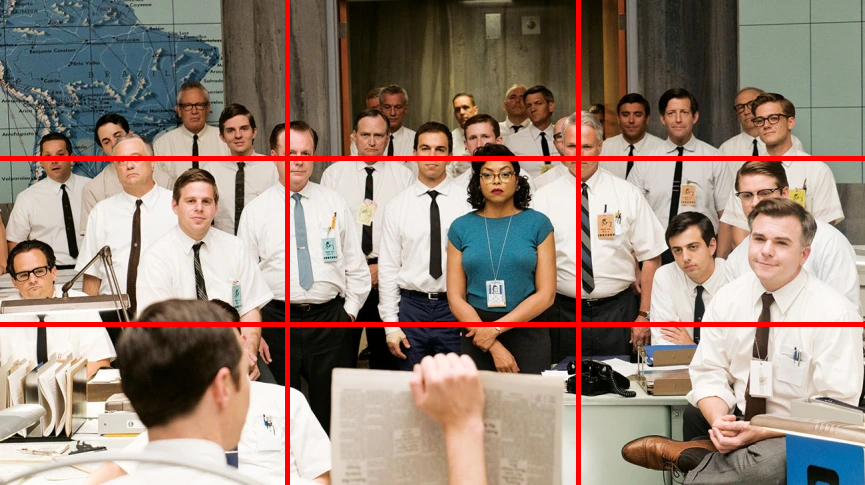Race in Fiction
Why study race in fiction?
As fundamentally personal forms of self-expression, arts and literature are a fertile area to explore the expressions of racialized experience.
In an ideal world, racial justice should be part of fiction in film and literature. Since fiction is part of our social life, fiction does reflect societal racial prejudices. We can use an anti-racist lens to interpret fiction and open it up for socially reparative discussion of race. It may be a cliché to say that art imitates life, but life more frequently becomes fiction’s self-fulfilling prophecy. Fiction has the power to change society. Therefore, it is crucial to apply critical race theory to analyses of film and literature.
Take, for instance, Theodore Melfi’s film Hidden Figures (2016). The biographical drama film features Katherine Johnson, a Black mathematician who played a vital role in the U.S. space program in the early 1960s. Let us analyze the composition of the following scene and consider how, before any word is uttered, the scene’s composition conveys to film audiences unspoken racial dynamics.
In this scene, the director (played by Kevin Costner) tells the NASA staff in Langley that they have to double their efforts in order to beat the Soviets in the Space Race. What do you notice here?

Katherine Johnson (played by Taraji P. Henson) is front and center. How does the filmmaker signal her importance and simultaneously outcast status at NASA? To help you along, here is the frame with the red grid showing the rule of thirds.

Composition
At work here is the power of composition. Composition in mise-en-scène refers to the organization of characters, objects, and the set. It involves a balanced relationship among these elements and lighting within a frame. Composition guides the film viewers’ attention.
As a general rule of thumb, the human gaze is drawn to the top area of a frame (the headroom). Filmmakers often use this space to convey the most important information, such as the face or eyes of a character. Close-up shots often feature actors’ eyes, because humans tend to be drawn to others’ eyes.
Composition can minimize or enhance the depth in a shot. As a result, how figures and objects appear on screen, however, can be very different to the arrangement on the set during shooting. Composition can also advance important plot elements. Composition not only serves film audiences. It can also serve the characters within the frame.
Lighting
Lighting is an important component of the aforementioned mise-en-scène. Film lighting creates both illumination and shadow. The interplay between light and shadow expresses the mood of a scene, defines a character, and shapes the cinematic space on screen.
Racial justice should be part of lighting strategies. Lighter skin tones tend to reflect more light, while darker colors tend to absorb it. Different skin tones also create different levels of shading. Poor lighting choices in some films have made characters and actors appear, quite literally, in a different light than who they are, or flatter only certain characters. The color of costumes also affects how the scene is lighted effectively. It takes more deliberate effort to provide lighting for several characters in the same scene who have different skin tones.
Lighting actors with darker skin tones has been a challenge, because major Hollywood studios traditionally devoted more resources to the perfection of lighting strategies to flatter lighter skin tones. Misuse of hard light had caused actors to sweat, and inappropriately distributed light prompted some actors to put vaseline on their skin in order to reflect enough light.
Case in Point
A game changer is Woman King, Gina Prince-Bythewood’s 2022 historical action drama film. In the following scene in the court, King Ghezo (John Boyega), his court, and General Nanisca (Viola Davis) are evenly and appropriately lit without overuse of hard light. The lighting team accomplished this despite the challenge of a back-lit set with a high dynamic range (high contrast between very bright and dark spots on the set).
Racial Minorities on Screen
Fiction has the power to reshape societies. A case in point is the history of cinematic representations of East Asian American women. In her keynote lecture at the Tucker Boatwright Festival in Richmond, Virginia, Alexa Alice Joubin argued (at 03:18) that the harmful notions of yellow peril and yellow fever converge to form techno-Orientalism in Hollywood representations of racialized others. “Yellow fever” manifests itself in stereotypes against Asian American women, but if we can identify tacit forms of misogynistic racism we can form better strategies for inclusion.
Racial Stereotypes
Representations of minorities often draw on stereotypes. Most actors and audiences critique stereotypes, but actor Constance Wu begs to differ. In Constance Wu’s “Welcome to Jurassic Park,” a chapter in her memoir, Making a Scene (2022), she offers a new perspective. People often ask Constance Wu: “Aren’t you perpetuating stereo-types by playing a tiger mom?” and “Why do you have to have a stereotypical accent?” Wu wrote that
To lots of people, sure, my parents’ accents sound like stereotypes. But to me? They’re my parents. I’ve heard a lot of Asian actors say that I refuse to play stereotypical roles.
The desire to shut down stereotypes, is a reaction to a Hollywood standard that was created by people who do not know us. I got into acting to be creative, not reactive.
Instead of being embarrassed of those stereotypical attributes, we can humanize and celebrate them. What’s so embarrassing about an accent? Our parents have accents because they know two languages. Let’s be proud of that.
Stereotypes are not harmful for their mere existence; they’re harmful for their reduction of a person or group.
In Crazy Rich Asians, Wu’s character Rachel Chu, finds herself at the intersection of racial stereotypes, colorism, and classism. Rachel, a middle-class Asian-American woman, travels with her boyfriend Nick to Singapore to discover, to her surprise, that Nick comes from an ultra-rich family. Upon meeting Nick’s mother, Eleanor Young, Rachel is scrutinized by her future mom-in-law. She lacks pedigree.
The following dinner scene depicts what is known as intra-group or internalized racism. Eleanor does not approve of Rachel due to her class background and “American” demeanor and attitude toward life (pursuing her passion). While both Eleanor and Rachel are Asian presenting, Eleanor uses her class privilege to reject Rachel and reinforce class-based racial hierarchies within the community.
Pay attention to her body language. Eleanor has her back to Rachel most of the time, giving orders to all the cooks who work for her. As Eleanor scrutinize the food being prepared, she is also “interviewing” Rachel and scrutinizing her just like the dishes on the table. The camera angle further highlights the height differential between Eleanor and Rachel. Eleanor is taller and physically and figuratively looks down on Rachel.
The scene also compels us to think deeper about the model minority myth that is often associated with Asian Americans, exposing how race intersects with class. Despite her socioeconomic status, Rachel is never “good enough” for Eleanor who is the matriarch of a wealthy family. Gender dynamics are also at play in the stereotype about unsympathetic moms-in-laws.
Your Turn: “White” Voice?
Is there such a thing as a racialized voice? What would it sound like? This is the question explored by Sorry to Bother You (dir. Boots Riley, 2018), a satire about race and the American dream. It presents an alternate reality in present-day Oakland. Struggling telemarketer Cassius Green has trouble retaining customers until his co-worker, Langston, teaches him to use his “white voice” and adopt a carefree, affluent persona on calls.
Watch the following short scene and analyze Langston’s demo of what he calls a white voice. What does he mean by the mannerism and way of speaking?
Other Cinematic Elements
Other film techniques also affect how audiences see or not see characters’ and actors’ racial identities. Here are two elements to consider:
- Intentioned and inclusive casting practices can contribute to films’ social justice causes. Since diverse casts disrupt the status quo, detractors of Rob Marshall’s 2023 The Little Mermaid, Netflix’s Queen Cleopatra, and of Amazon’s new Lord of the Rings series claim that casting Black and Asian actors undermines these stories. Casting choices involve real-life individuals in a fictional world, and (self) representation can be socially reparative. Of course, there are pitfalls. Diverse casts alone is not enough. We need inclusive filmmaking techniques (such as lighting and framing, see above). As Aja Romano writes, “diverse casting can be a shortcut to appearing progressive without actually being progressive.” Alexa Alice Joubin has researched this phenomenon, writing that “advertising trends sometimes give false impressions of the works’ inclusiveness.”
- A combination of these and other techniques, such as a fuzzy focus and an extreme close-up with no discernible background position the characters outside the narrative time and space. Due to the ways in which audiences are invited to view them, these sexualized characters become “inconsequential” to the story. When characters are disconnected from their environments, they are disempowered. They are not able to influence their surroundings and appear more abstract and less of a real person.
